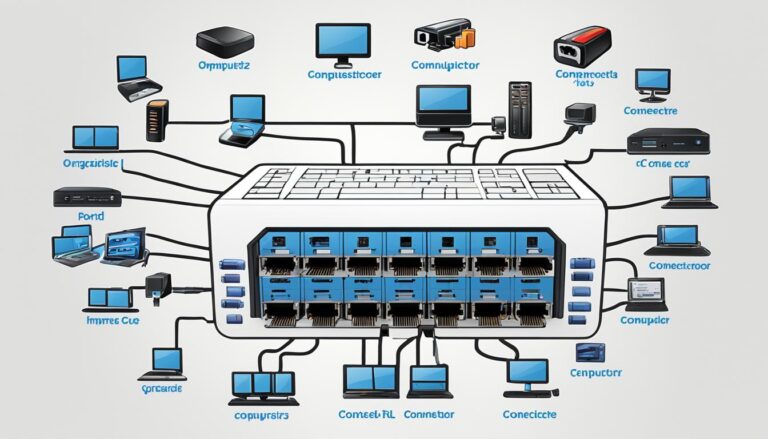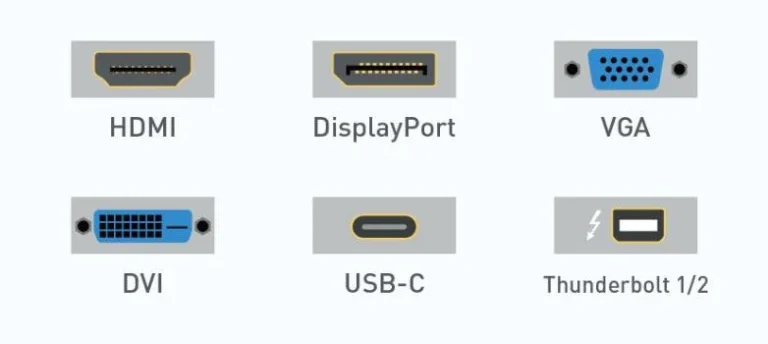Welcome to our guide on computer monitor connectors. We’ll look at the different types you can use. It’s key to know about these to make sure your display works well.
If you’re creating a home cinema or using professional video gear, knowing your connectors helps. It boosts your experience. You’ll learn about HDMI, VGA, USB-C, and Thunderbolt connectors here.
We’ll talk about what each connector does well and its limitations. And, where it’s best used. By the end, you’ll know all about these connectors. This knowledge will help you set up your monitor right.
So, let’s get started on discovering the exciting world of monitor connectors.
HDMI Connectors
HDMI connectors are commonly used for TV to PC connections. They provide both audio and video signals. They’re perfect for home entertainment systems and can handle high-quality audio and video
With HDMI connectors, linking computers or laptops to TVs or monitors is simple. This makes watching movies, playing games, or presenting smooth. The audio and video transmission is reliable and clear.
HDMI connectors come in various versions, with HDMI 2.1 being the latest. It supports higher resolutions, up to 10K, and offers better color depth. Quick Media Switching and Variable Refresh Rate (VRR) are among its new features.
A big advantage of HDMI connectors is their ability to send audio and video through one cable. This reduces the need for many cables, making setup easier and neater.
Moreover, HDMI connectors support HDCP. This is crucial for the secure streaming of copyrighted content. It helps protect streamed services and home theaters from copyright issues.
In summary, HDMI connectors are a dependable choice for connecting various devices. They ensure high-quality audio and video. This makes them ideal for any setup needing audiovisual connections.
Advantages of HDMI Connectors:
- Supports both audio and video signals
- Compatible with various devices
- High-quality audio and video transmission
- Supports high resolutions and features
- Reduces cable clutter with a single cable solution
- Secure transmission of copyrighted content
DVI Connectors
DVI connectors are mainly for video transmission, great for old systems or high frequencies at 1080p. They have better picture quality than VGA and can handle both analog and digital signals. You can find Single Link DVI for resolutions up to 1920×1080 pixels and Dual Link DVI for up to 2560×1600 pixels.
For video only and high frequencies, DVI connectors are perfect. They suit older systems without HDMI or DisplayPort. Thanks to their high-quality video signals, DVI connectors provide crisp, vibrant visuals.
In industries like gaming, video editing, and professional graphics design, DVI connectors are a top choice. They handle high frequencies well, which gamers love for fast, precise visuals. They also work with older, analog signals, making them versatile for various setups.
Advantages of DVI Connectors:
- Top-notch picture quality for video transmission
- Supports high frequencies at 1080p resolution
- Backward compatibility with analog signals
- Works well with older systems
DVI Connectors Comparison:
| DVI Connector Type | Resolution | Signal Type |
|---|---|---|
| Single Link DVI | Up to 1920×1080 pixels | Analog and digital |
| Dual Link DVI | Up to 2560×1600 pixels | Analog and digital |
DisplayPort Connectors
DisplayPort connectors are known for supporting high resolutions and audio. They are often seen on PCs. This makes them perfect for things like movies and games.
These connectors allow for long cables. This is great for both desktop PCs and laptops. They ensure brilliant visuals with up to 8K resolution. This is key for gaming, content creation, and sharp displays.
DisplayPort connectors do more than just video. They also carry audio without extra cables. This makes setup easier and keeps things tidy. It provides a smooth experience for users.
Key Features of DisplayPort Connectors:
- Support for high resolutions up to 8K
- Audio transmission capabilities
- Long cabling lengths for flexibility
- Compatible with a wide range of devices
- Reliable and high-quality video transmission
In short, DisplayPort connectors are great for top-notch resolution and sound. They stand out for both work and play, thanks to their dual capability. They really are essential!
VGA Connectors
VGA connectors, also known as Video Graphics Array connectors, are the oldest type of connectors. They are seen as a legacy video connector. These connectors work by transmitting video signals as continuous electrical signals instead of digital data packets. They were often used with CRT displays to connect computers to monitors.
Even though they are analog, VGA connectors could still deliver decent image quality back in the day. But as technology evolved, the need for sharper image resolutions increased. Hence, VGA connectors became less common in new devices.
However, VGA connectors are still present on some devices like home players and projectors. They offer a solid connection option for older equipment.
VGA connectors may not be the first pick for high-resolution digital displays anymore. Yet, they provide a cost-effective answer for setups that don’t need the latest tech.
The preference for VGA connectors has dropped due to HDMI, DVI, and DisplayPort connectors. These newer options support better image quality and digital signal transmission. They also offer higher resolutions, improved color quality, and work well with modern devices.
| VGA Connector | Description |
|---|---|
| Connection Type | Analog |
| Signal Type | Video Only |
| Maximum Resolution | 1920×1080 pixels |
In conclusion, VGA connectors belong to an older generation of video connectors. Their analog approach makes them less prevalent in today’s devices. Yet, they are still useful for certain needs. For top-notch image quality and current tech compatibility, HDMI, DVI, and DisplayPort connectors are the better options.
USB-C and Thunderbolt Connectors
USB-C and Thunderbolt ports do more than you might think. USB-C is known for its all-round abilities. It can handle video, audio, data, and even power. It works with lots of different gadgets, which makes it super handy for modern tech needs.
Thunderbolt ports came from Intel and Apple working together. They changed how we plug things into computers. At first, Thunderbolt 1 and 2 looked like Mini DisplayPort connections. But then, Thunderbolt 3 switched to USB-C, giving us more ways to connect.
This blend of Thunderbolt and USB-C means users get the best of both. It offers superfast data transfer, crystal-clear video, and can even charge devices. And it’s all through one small, easy-to-use port.
With these connectors, plugging in laptops, phones, and other tech to things like screens, docks, and hard drives is a breeze. The design is clean and simple. This makes it a top pick for professionals, gamers and just about anyone.
Benefits of USB-C and Thunderbolt Connectors:
- High-speed data transfer
- Support for high-resolution video output
- Power delivery capabilities
- Ability to connect to a wide range of devices and peripherals
- Compact and versatile design
Comparison: USB-C vs. Thunderbolt Connectors
| Feature | USB-C | Thunderbolt |
|---|---|---|
| Data Transfer Speed | Up to 10 Gbps (USB 3.1 Gen 2) | Up to 40 Gbps |
| Video Output | Up to 4K resolution | Up to 8K resolution |
| Power Delivery | Up to 100W | Up to 100W |
| Compatibility | Compatible with various devices and peripherals | Compatible with Thunderbolt-enabled devices |
USB-C connectors are now common in devices like laptops and phones. Big brands like Apple, Dell, and Samsung use them a lot. They’re super useful and found on many new gadgets.
Thunderbolt ports are often seen in professional environments. They suit power users who need top performance and Thunderbolt-ready gear.
Both USB-C and Thunderbolt connectors have changed how we connect our tech. They make it easier and more convenient to link our devices, offering great flexibility and choice.
Other Connectors
There are many connectors like HDMI, DVI, DisplayPort, VGA, and USB-C used with computer monitors. Yet, some connectors are made for certain tasks. These include AV (RCA) connectors, NDI connectors, and SDI connectors.
AV Connectors
AV or RCA connectors are used to send analog audio and video. They have three cables: red for right audio, white for left audio, and yellow for video. You’ll find them in entertainment systems, consoles, and audiovisual gear.
NDI Connectors
NDI connectors help send audio and video over a network. NDI technology by NewTek makes high-quality, low-delay streaming possible. They’re loved in broadcasting, live events, and video making because they work well with NDI devices.
SDI Connectors
SDI connectors are key in pro video making. They send digital video far distances with reliability. Their sturdiness makes them perfect for live TV, studios, and other high-stakes settings that need stable signals.
SDI has a few types, like SD-SDI, HD-SDI, and 3G-SDI, each for different video qualities. They mostly use BNC connectors that lock in place, ensuring a good connection.
| Connector Type | Common Use Cases |
|---|---|
| AV (RCA) | Home entertainment, gaming consoles, audiovisual equipment |
| NDI | Broadcasting, live events, video production workflows |
| SDI | Professional video production, live broadcasts, studio setups |
Each connector type is designed for its own special tasks. While HDMI, DVI, DisplayPort, and VGA are seen in everyday gadgets, AV, NDI, and SDI serve specific industries. They are crucial for transmitting audio and video well.
Conclusion
In summary, the world of computer monitor connectors is vast and varied. There are many options to choose from. Each one serves different needs and tastes. Whether you need the ease of HDMI and USB-C or the steadiness of DVI and SDI, there’s a connection for every scenario.
HDMI connectors bring both sound and video in one go, while DVI is great for high quality pictures. DisplayPort is excellent for supporting high resolutions with sound. VGA may be old but still fits in some devices. USB-C and Thunderbolt offer a single solution for all ports. Meanwhile, AV, NDI, and SDI meet unique demands in different fields.
The decision on which connector to use depends on your device’s needs and the quality you want. It’s vital to check compatibility and industry needs to make a smart choice. Knowing the features and what each connector can do helps in getting a smooth and dependable link between your computer screen and your device.
FAQ
What are the different types of computer monitor connectors?
There are many types of connectors for computer monitors. These include HDMI, DVI, DisplayPort, VGA, and USB-C. Other types are Thunderbolt, AV (RCA), NDI, and SDI connectors.
What is the purpose of HDMI connectors?
HDMI connectors are great for connecting TVs to PCs. They carry both sound and picture. This makes them ideal for home entertainment systems, offering high-quality images and sound.
What are DVI connectors used for?
DVI connectors focus on video. They’re good for old systems or high-resolution video at 1080p. Unlike VGA, they give better picture quality. They support both analog and digital signals.
What are the advantages of DisplayPort connectors?
DisplayPort connectors are great for high-resolution screens and sound. You’ll find them on many PCs. They handle stereo sound well.
What is the nature of VGA connectors?
VGA connectors are quite old. They’re known as legacy video connectors. They’re analog and were used with CRT screens.
What capabilities do USB-C and Thunderbolt connectors offer?
USB-C connectors are versatile. They send video, audio, data, and power. Thunderbolt connectors connect peripherals and monitors to a computer. They’re very useful.
Are there any other types of connectors available?
Yes, there are others like AV (RCA) connectors for analog signals. NDI connectors send audio and video over Ethernet. SDI connectors are great in production for their range and reliability.
How should I choose the right connector?
Choosing depends on your needs and device compatibility. Think about the quality of sound and picture, compatibility, and industry needs.












